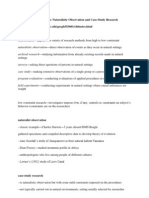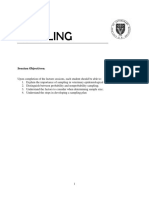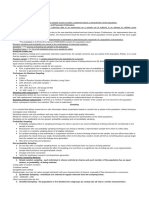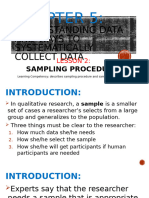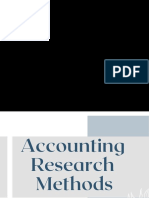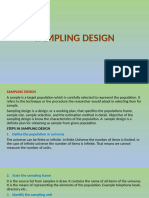0 ratings0% found this document useful (0 votes)
88 views3
Steps should be taken to ensure that the surey is under statistical control so the that the
collected information is in accordance with the pre-defined standard of accurace
Uploaded by
Fitehalew DemilewCopyright
© © All Rights Reserved
Available Formats
Download as TXT, PDF, TXT or read online on Scribd
0 ratings0% found this document useful (0 votes)
88 views3
Steps should be taken to ensure that the surey is under statistical control so the that the
collected information is in accordance with the pre-defined standard of accurace
Uploaded by
Fitehalew DemilewCopyright
© © All Rights Reserved
Available Formats
Download as TXT, PDF, TXT or read online on Scribd
You are on page 1/ 2
1. Formulating the research problem.
2. Extensive literature survey.
3. Developing the working hypothesis.
4. Preparing the research design.
5. Determining sample design.
- All items under concideration in any field of inquiry constitues a universe or
population.
- A complete enumeration of all items in a population is known as census inquiry.
. This can be persumed when evry items are coverd and there are no chances left so
that high degree of accurace is achived
- But this is not possible in practicall coz even the slightest bias can get larger
and larger when the number observations ncrease
- Sample is a definite plan before collecting a data to select it to include in to
the sample from a population.
- There are two types of sampling probability sample and non-probability sample.
- Probability sample every item in a population has a known probability of being
included in the sample.
- Non-probability sample the researcher will not be allowed to give probability for
the items to be included in the sample.
- Deliberate sampling it is also known as perpesive or non-probability
sampling.
- When items are selected to be include in the sample based on there ease of
access then it can be called convienence sampling.
- Judgement sampling ; the researchers judgement is used to select items to
include in the sample.
-- Simple random sampling is alos known as chance sampling or probability
sampling . every items in the
population has equal chance of being included in the sample.
-- Systematic sampling selecting every Nth item to be included in the sample
-- Stratified sampling when the population in which sample will be selected
constitue non-homegenous groups . the population will be stratified into
non-overlaping homegneous groups called strata. Then sample will be
selected from this stratums.
when samples elected randomly from the sratas then we call it startified
random sampling.
-- Cluster/area sampling. When the population is larg or the geographical
area is big then the population will be dived into smaller clustrs
then among the clusters the sample will be selected.
-- Area sampling whne the general goegraphical area is to big then it is
divided into smaller areas an those are will be include in the sample
-- Multi- stage sampling is a further expansion of cluster sampling this
used when the geographical area is excesively too larg
-- Sequencial sampling is used when the sample is not known in advance and it
will determined by some mathimatical formula.
-- The researcher must select one of the sampling methods for him self he
must consider the following
- The nature of the investigation.
- The scope and objective of the inquiry.
- The avilable financial resources.
- The time and the skill of the researcher too
6. Data collection.
exeprimentation adn survey
one of the ff surveying methods
.. By onservation
.. Through personal interivew
-- Through telephone interview
-- By mailing of questionary
-- Through schedules
7. Execution of the project.(3).
- If the execution of the project proceeds on correcct lines the data to be
collected would be and dependable
- The researcher should see that the project is executed in a systematic manner and
in tieme.
-Steps should be taken to ensure that the surey is under statistical control so the
that the
collected information is in accordance with the pre-defined standard of accurace
8. Analysis of the data.
9. Hypothesis testing.
10. Generalization and interpretation
11. Preparing the report
You might also like
- Sherlock Bones PPT MB BW RV JJ 1415 5 HumerusNo ratings yetSherlock Bones PPT MB BW RV JJ 1415 5 Humerus19 pages
- Chapter 6 Field Research: Naturalistic Observation and Case-Study ResearchNo ratings yetChapter 6 Field Research: Naturalistic Observation and Case-Study Research5 pages
- Sampling Techniques and Sample Size DeterminationNo ratings yetSampling Techniques and Sample Size Determination104 pages
- Risma, Mary Grace U. BEED 2-A (Module 5, Lesson 1 Application)No ratings yetRisma, Mary Grace U. BEED 2-A (Module 5, Lesson 1 Application)4 pages
- Samplin G Design: Presented By:-Siddharth KishanNo ratings yetSamplin G Design: Presented By:-Siddharth Kishan43 pages
- Sampling and Its Types Part - 2 - Ajay KumarNo ratings yetSampling and Its Types Part - 2 - Ajay Kumar5 pages
- Lesson 2.4 the Sample and Sampling Procedure CopyNo ratings yetLesson 2.4 the Sample and Sampling Procedure Copy40 pages
- Practical Research Samples and Sampling Techniques UsedNo ratings yetPractical Research Samples and Sampling Techniques Used3 pages
- 1st Sem 2nd Q W2 Sampling Techniques PDFNo ratings yet1st Sem 2nd Q W2 Sampling Techniques PDF53 pages
- C 3 and C 5 RESEARCH DESIGN AND SAMPLINGNo ratings yetC 3 and C 5 RESEARCH DESIGN AND SAMPLING15 pages
- Research Methods and Methods in Context Revision Notes for AS Level and A Level Sociology, AQA FocusFrom EverandResearch Methods and Methods in Context Revision Notes for AS Level and A Level Sociology, AQA FocusNo ratings yet
- Tectalik Corporate Profile - Business Health & Performance ManagementNo ratings yetTectalik Corporate Profile - Business Health & Performance Management12 pages
- Case Files Obstetrics and Gynecology 5Th Edition Eugene C Toy Full Chapter100% (9)Case Files Obstetrics and Gynecology 5Th Edition Eugene C Toy Full Chapter67 pages
- Introduction To Mass Transfer and DiffusionNo ratings yetIntroduction To Mass Transfer and Diffusion17 pages
- IATG 01.50 UN Explosive Classification System and Codes v.2No ratings yetIATG 01.50 UN Explosive Classification System and Codes v.229 pages
- CH 13 and 14 AP MC and Short Answer AnswersNo ratings yetCH 13 and 14 AP MC and Short Answer Answers10 pages
- Absa Group Limited Is One of South AfricaNo ratings yetAbsa Group Limited Is One of South Africa11 pages
- Quick Revision Notes Class 12 Chemistry Term 1 1No ratings yetQuick Revision Notes Class 12 Chemistry Term 1 114 pages
- Discuss The Medical and Industrial Uses of Gamma RaysNo ratings yetDiscuss The Medical and Industrial Uses of Gamma Rays5 pages
- BTS7960 Motor Driver Datasheet and Circuit DiagramNo ratings yetBTS7960 Motor Driver Datasheet and Circuit Diagram27 pages





